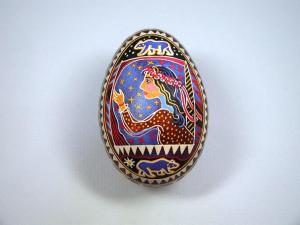Building the House of Bears – Notes from the book launch, November 2009
by Orysia Dawydiak

I’ve been thinking about writing this book for a very long time. The seeds were planted before I could read or write, while I listened to the stories of my grandmother and my parents. They described their lives in Ukraine in the 30’s and 40’s, then in Italy and Germany during the Second World War, England after the war, and finally emigrating to Canada in 1951. Some of those stories were horrendous, the source of childhood nightmares. I really wonder about my grandmother, as I sat on her lap, hearing her vivid descriptions of Nazis torturing women and bayoneting babies. It seems some of the women in my family have a penchant for over sharing. I hope I’m not one of them, but I suppose that will be for my readers to judge.
Like most teenagers, I butted heads with my parents from time to time, frustrated by all their rules and restrictions and expectations for me. I think I had my dad figured out, but my mother continued to be a mystery to me; her often irrational, emotional, way of dealing with problems, of which I considered myself to be number one on her list. But I was young and the world revolved around me. Over the years and with some distance, I tried to understand what made her the person she was. I kept returning to her childhood, to her survival of the Nazi occupation and the war. I tried to be empathetic and wondered if I could have endured what she had and emerged with my sanity intact.
Linden MacIntyre, in his talk here a few weeks ago, made a comment which intrigued me. He spoke of life experiences and traumas suffered by one generation during times of war for instance, how they dealt with such upheavals, and how their behaviour in turn affected the next generation, much like genetic traits are passed on from parents to offspring. It made sense to me. I’m sure I was traumatized by my grandmother’s stories. I still tend to avoid serious movies about the Second World War. They send me to an uncomfortable place, where I become anxious in spite of my rational brain informing me that it’s only a friggin’ movie.
All this to say that the genesis for House of Bears started with trying to understand my parents and other immigrants, and how they reacted to the world around them. During my retrospective research, I regained a deep admiration for the migrants who left their homes during wars and under oppression and settled in strange new countries. I felt a need to express my gratitude, and was compelled to write their stories, like so many others had done already. It’s a story that continues today because the wars never stop; people around the world are being displaced every hour of every day.
This fall I had the opportunity to visit Pier 21 in Halifax for the very first time. I knew my parents had sailed from England on a ship named the Georgic in1951, and had landed in Halifax before taking a train and float plane to the mosquito-infested outback of Manitoba, where they lived for a very short while. I had taken a university course on immigration to Canada in the 20th century and thought I was well-informed about that period of our history. But I was not prepared for the emotional impact of what I heard and read and saw as I wandered through the displays. I felt like I was absorbing the emotions of all the immigrants who had passed through, thousands of them, grieving for what they had lost, anxious about what lay ahead, relieved to have landed, hopeful that they had left the terror and poverty behind them forever. My head was going to explode from the pressure, it began to leak. I could not stop crying. I had to leave before I had a total meltdown.
I tried to understand what had just happened to me in there. Was I still carrying around all those terrifying stories from childhood, emotions that had never been completely processed, disassembled and dealt with? Had the original experiences of my parents and grandparents become as much a part of me as it was of them? Was this what had been passed down to me?
The House of Bears is a work of fiction, which made it’s own path and took on it’s own life as I wrote it. It took me places I didn’t know existed. Still, it sits on a foundation of history; world history, and personal histories. I am grateful to my family for providing that foundation, and to my friends, my publisher and editors who supported me while I built and decorated the house. The front door was provided by a dear friend and gifted artist, then photographed by an equally talented photographer. This pysanka, a Ukrainian batik egg, was created for this book. It’s an apt symbol; I feel like I’ve been incubating this egg for a long, long, long time and now it has finally hatched.


Art begets more art. Behold the amazing workwomanship of this incredible hooked rug, based on the pysanka Elaine made for my book cover. This artwork, which hangs on a wall in my dining room. was created by Christine Doucette, rug-hooker extraordinaire.

What about translation to Ukrainian? 😉
LikeLike
Oleh, if someone offers to translate the book into Ukrainian they can contact me.
LikeLike